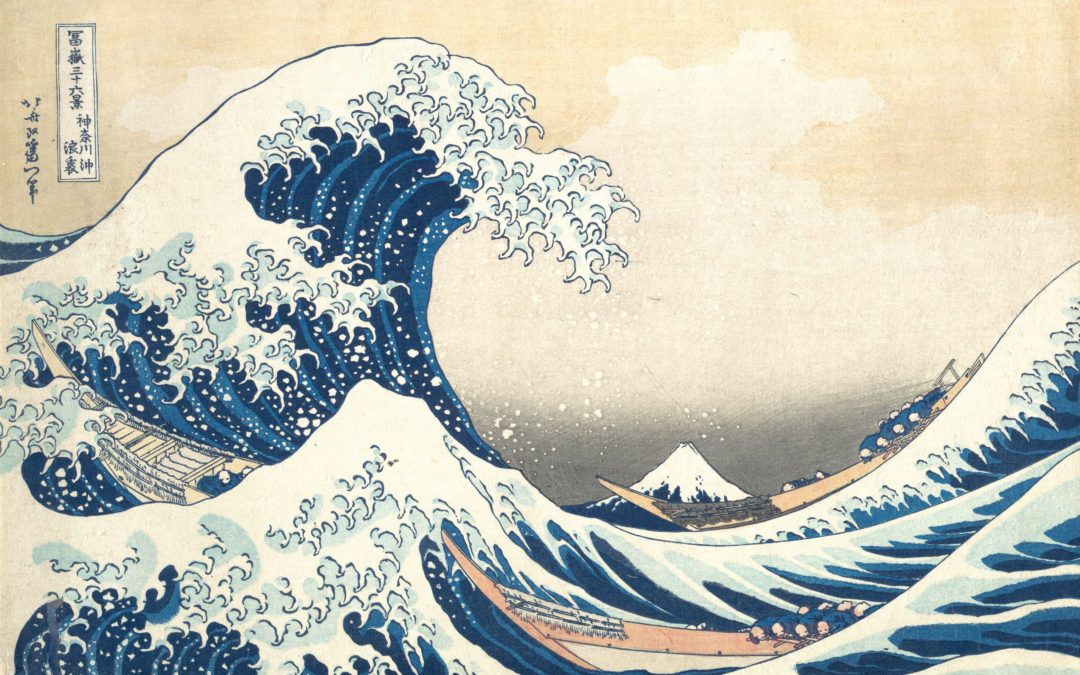An emblematic and symbolic work that has long been engraved in the memory of Japan and consequently in that of Asia, the Great Wave of Kanagawa is a phenomenal artistic work created by the masterful hand of Katsushika Hokusai, a Japanese artist whose reputation is well known. Let’s discover the unique history of a painting that revolutionized the codes and transcended the times and became eternal!
When was the great wave of Kanagawa created?
The Great Wave of Kanagawa is a Japanese representation of the painter of the same nationality, Hokusai. The publication of this work is mysterious, as its official publication date has never been clearly determined. Many believe that the print was published in 1830. For others, it would be listed in 1831. All in all, this print was published during the Edo period.
What is the history of the great wave of Kanagawa?
A complete work by the artist Hokusai and the first in his series Thirty-six Views of Mount Fuji, Kanagawa, The Great Wave of Kanagawa also known as Hokusai’s Wave, overturns the codes of Japanese artistic history. Prints emerged in Japan as early as the 13th century and were mainly interested in religion. From the middle of the 17th century onwards, they focused on secular subjects. Also known in Japanese jargon as ukiyo-e (a print printed on paper using woodblock reproductions made by an experienced engraver after the artist’s work), they proved to be innovative because the technique of woodblock printing was a considerable asset: it ensured a much wider distribution of works than with painting, whose major handicap was the originality of the artwork.
Why the big wave of Kanagawa?
Hokusa’s work was created to expose to the world the humble way of life of the people living in the countryside of the Land of the Rising Sun. The Great Wave is part of a series of ukiyo-e prints depicting the everyday images of Japanese life. The work was also born to bring a new breath to the artistic field of the country.
Indeed, this work ushers in a new era in the Japanese artistic landscape in that it is the mother work of the great meisho-e series. It appropriately synthesizes the charm and aesthetics of ukiyo-e, thus promoting an opening to the Western world.
The great wave of Kanagawa technique
The Wave of Kanagawa disrupts the codes of the Japanese social stratum due to the fact that secular images, from the 17th century onwards, underpin the birth of a social class. This is the urban merchant bourgeoisie of the most affluent which appeared in the middle of the Edo period. It is derived from the category of brocade representations. Each colored part of the canvas is obtained by the application of a particular wooden board.
The Wave of Kanagawa is a harmonious work of art by the renowned artist Katsushika Hokusai (October 31, 1760 – May 10, 1849). He used the usual and well-known techniques of ukiyo-e to create the painting. He was responsible for the artistic aspects, the drawing and the choice of colors of the canvas. However, it should be noted that this beautiful and timeless result is not the result of Katsushi Hokusai’s work alone. Kanagawa is the result of a collective work that brought together several emblematic figures of the artistic field.
The great wave of Kanagawa: what is its meaning?
In this artistic piece by Hokusai, Mount Fuji, the highest point in Japan and a symbol of beauty, is seen from the sea and framed by a gigantic, feline wave. The wave and its foam are about to come crashing down on the fishermen and their boats. This ripple commands the canvas, concealing both the mountain and a trio of boats; thus inspiring Hokusai to title it The Great Wave.
The most striking element of the painting is the large Japanese wave that is about to break with the crash of its horn-like top. The beautiful dark blue pigment used by Hokusai, called “Prussian blue”, which was a new material at the time, was imported from England via China. The wave is about to hit the boats as if it were a huge human devourer, which would symbolize the extraordinary power, firmness and robustness of nature and the deficiency of human beings.
Where is the big wave of Kanagawa exposed?
The allegorical work of Hokusai remains continuous and very exploited. Indeed, the one who is considered the Japanese Mona Lisa, notably because of its timeless influence on the West, has been the subject of numerous reproductions over the years. Numerous copies of the work are preserved throughout the world. Among the collections among which we find the wave off Kanagawa, we can distinguish :
- The Guimet Museum in Paris (whose copy of the Great Wave comes from a bequest of Raymond Koechlin, a prominent journalist, deed dated 1932;
- The Metropolitan Museum of Art in New York (from one of Henry Osborne Havemeyer’s former collections dating from 1929);
- The British Museum in London;
- The Bibliothèque Nationale de France (including the copy acquired in 1888 from the collection of Samuel Bing);
- Claude Monet’s collection in France, in Giverny;
- The Art and History Museum in Brussels.
Ultimately, the importance of the Great Wave of Kanagawa must be recognized. Much more than the love letter it represents to nature and Japan, this artistic piece undoubtedly represents a timeless heritage coupled with an impeccable visual workmanship.
An unforgettable masterpiece that has transcended the ages and continues to serve as an inspiration to contemporary artists. It is not surprising that we can find on the market t-shirts bearing the effigy of this work. A weapon of massive moral and ecological impact, irrefutable proof of the immortality of art and its artist, an avant-garde, philosophical and resurgent work, the Japanese Mona Lisa is undeniably prodigious. No one doubts that it will remain forever present in our minds.
